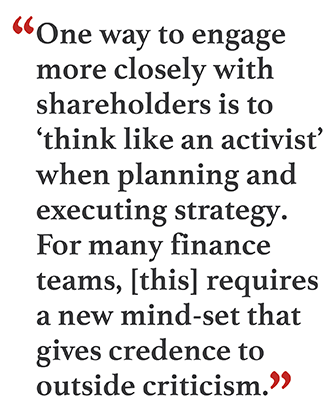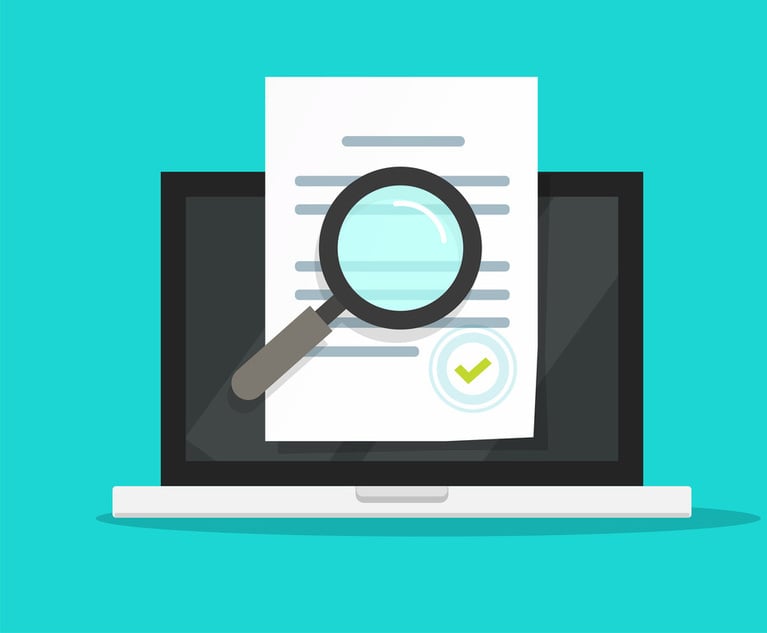
Like most functions at large organizations, investor relations (IR) has undergone significant change in recent years. A tighter alignment between IR and finance disciplines such as treasury—including, increasingly, as a rotational assignment for future treasurers and CFOs—has equipped many IR leaders to better address investor concerns.
As the responsibilities and capabilities of the IR function have evolved, CEOs, CFOs, corporate treasurers, and IR leaders have begun seeking to understand how to employ an assortment of technologies to better communicate with the investor community. At the same time, activist and other large investors are exploring ways to leverage technology to gather more intelligence about what is happening inside the corporate fortress, for signs of success or weakness that could impact their holdings.
The year ahead will likely see this dynamic continue to play out on both sides of the corporate fence.
Telling a Stronger Story to the Street
Many of the same technologies that are transforming workflows within the treasury and finance functions—including analytics tools, artificial intelligence (AI), and robotic process automation (RPA)—have the potential to substantially improve the IR team's effectiveness in preparing for earnings calls and communicating to investors.
One of the biggest challenges CFOs face when preparing for an earnings call is accessing up-to-the-minute data from multiple systems—for example, a treasury workstation and an enterprise resource planning (ERP) system. In the narrow window between the financial close and the actual earnings release, the CFO and CEO need to collect and collate massive amounts of information.
They must have accurate final numbers, of course, but they might also need deeper insights to tell the Street a stronger story in areas such as sales, marketing, or compliance, depending on the business model. Today, new analytics tools can help generate these types of insights by pulling in data from across systems in much shorter times. Paired with improved financial close processes, these tools can give CFOs much faster access to a range of metrics and more time to evaluate the implications of the data. This means CFOs and IR leaders can craft a richer narrative about where the company has been and where it is heading.
In addition, IR teams are increasingly taking advantage of technologies that provide insights into stakeholder perceptions about the business or marketplace. These solutions gather information from social media and other modern communication channels, then turn that data into knowledge that corporate leaders can use to gauge the effects on their company of trends in the external business environment.
The combination of these technologies can enable executives to go into earnings calls better prepared for potential questions from analysts and investors. In fact, some of the latest IR-related tools are designed to help CFOs and CEOs understand how to convey certain types of information. For example, cognitive technologies such as natural language processing and machine learning can evaluate words and sentence structure to correlate how a CEO's prepared comments about strategy, or a CFO's planned response to an expected analyst question, might impact broader perceptions—and perhaps even move the stock.
Such a solution could be particularly helpful for a company that is struggling to improve its messaging to the capital markets or in a situation where investors have not rewarded a strategy that shows potential to build shareholder value. In these cases, better understanding the investment community's likely perceptions of the management team's past and expected future comments could provide insights that improve the effectiveness of their communication to the Street.
Predictive Analytics Give a View to the IR Future
Another area in which IR-related technologies have been advancing rapidly is in their risk-sensing capabilities. New solutions can monitor vast quantities of information from external sources—from social media to analyst reports. They can enable the C-suite and IR team to understand the potential impact of communications to investors, which can help inform their handling of earnings calls and other IR activities in the future. In fact, organizations can use such technologies to help shape a wide range of decisions that might impact sentiment among both investors and other stakeholders, including customers, employees, and regulators.
 Consider Company X, which is in an industry where a major event is currently unfolding that has the potential to draw in many leading players, and Company X's management team convenes to figure out how to respond. Executives in this situation often face a choice: either stay silent and hope the controversy ends soon, or else offer a statement that attempts to get in front of the unfolding issue. As Company X decides what to do, one option at its disposal is to deploy a modern tool to mine the Internet and other sources for intelligence on trends related to perceptions of the impending crisis.
Consider Company X, which is in an industry where a major event is currently unfolding that has the potential to draw in many leading players, and Company X's management team convenes to figure out how to respond. Executives in this situation often face a choice: either stay silent and hope the controversy ends soon, or else offer a statement that attempts to get in front of the unfolding issue. As Company X decides what to do, one option at its disposal is to deploy a modern tool to mine the Internet and other sources for intelligence on trends related to perceptions of the impending crisis.
The latest generation of tools can gather information across thousands of sources that exist inside and outside of corporate walls. Internal sources of information might include customer feedback, emails, call center records, and service histories. External sources include news feeds, social media, and regulatory alerts. RPA and analytical modeling technologies enable these solutions to assimilate and aggregate countless, diverse streams of information to help create a cohesive narrative about a looming issue. For Company X, such a tool could tell executives whether their organization is in the crosshairs of marketplace conversations about the problem or shifting public opinion.
In addition, predictive analytics can help corporate leaders gauge public impressions of the business, in conjunction with other available sources over time. For example, Deloitte Risk and Financial Advisory utilizes a predictive social intelligence engine that operates in real time and can predict the volume, velocity, and direction that a digital conversation may take over the next 72 hours. IR and other executives at Company X could use the outputs of this type of tool to help drive actionable strategies, and to make better decisions about whether to comment publicly about the controversial issue as it unfolds and what to say. Without such information, they might make their decisions prematurely or in the dark, to the potential detriment of the company's reputation and value.
The new generation of analytics tools works so fast that IR professionals and the C-suite can gain an almost real-time view into perceptions as they are unfolding in the marketplace. Just a few years ago, organizations would pay to have investor sentiment studies conducted, including one-on-one interviews with investors. Such an approach can provide valuable information, but views change quickly, and even recently gathered sentiments can become quickly outdated. New cognition and other tools can help identify emerging developments, such as evolving consumer sentiments about a social issue or regulation, as well as shifts in correlations across multiple data sets, for greater insight and clarity.
Building a Stronger Dialogue with Major Investors and Activists
Even as these tools develop to help organizations better communicate with their investors, technological advances are also helping the investment community gather and analyze more and more information about company performance. And investors are wanting more access to directors and senior management so that they can better understand corporate strategy and investments. Building a stronger dialogue with both the shareholder community and activist investors is crucial in today's information-rich environment.
One way for a corporate management team to engage more closely with shareholders is to “think like an activist” when planning and executing strategy. IR-related analytics tools can give CFOs and other executives a new degree of intelligence in identifying weaknesses that activist investors may perceive, and then moving strategy forward. Core to this ability is having more high-quality information in hand sooner, so that in-house teams can identify problems and issues before others come knocking. For many finance teams, such an approach requires a new mind-set that gives credence to outside criticism.
Advanced customer relationship management (CRM) technologies can also enable management to increase engagement with major shareholders. The IR team can use a CRM tool to track and manage interactions between large investors and individuals across the organization, including board members. AI and analytics processes are being added to those more traditional technologies to enable better understanding and tracking of investor behaviors, publications, and comments. The analysis that can be synthesized and derived across these multiple sources can provide timely insights and perspectives into the issues that matter most to specific investors.
Together, the various technologies available to the IR function, and corporate treasurers and CFOs, can help them keep pace with changes in investors' and analysts' perceptions. This capability, in turn, enables IR to better drive performance and value across the company.
Chris Ruggeri is a national managing principal of Deloitte Risk and Financial Advisory's Risk Intelligence market in Deloitte Transactions and Business Analytics LLP.
This publication contains general information only and Deloitte is not, by means of this publication, rendering accounting, business, financial, investment, legal, tax, or other professional advice or services. This publication is not a substitute for such professional advice or services, nor should it be used as a basis for any decision or action that may affect your business. Before making any decision or taking any action that may affect your business, you should consult a qualified professional advisor. Deloitte shall not be responsible for any loss sustained by any person who relies on this publication. As used in this document, “Deloitte” and “Deloitte Risk and Financial Advisory” means Deloitte & Touche LLP, which provides audit and risk advisory services; Deloitte Financial Advisory Services LLP, which provides forensic, dispute, and other consulting services; and its affiliate, Deloitte Transactions and Business Analytics LLP, which provides a wide range of advisory and analytics services. These entities are separate subsidiaries of Deloitte LLP. Please see www.deloitte.com/us/about for a detailed description of our legal structure. Certain services may not be available to attest clients under the rules and regulations of public accounting. Deloitte Risk and Financial Advisory helps organizations effectively navigate business risks and opportunities—from strategic, reputation, and financial risks to operational, cyber, and regulatory risks—to gain competitive advantage. We apply our experience in ongoing business operations and corporate lifecycle events to help clients become stronger and more resilient. Our market-leading teams help clients embrace complexity to accelerate performance, disrupt through innovation, and lead in their industries. Copyright © 2019 Deloitte Development LLC. All rights reserved.
Complete your profile to continue reading and get FREE access to Treasury & Risk, part of your ALM digital membership.
Your access to unlimited Treasury & Risk content isn’t changing.
Once you are an ALM digital member, you’ll receive:
- Thought leadership on regulatory changes, economic trends, corporate success stories, and tactical solutions for treasurers, CFOs, risk managers, controllers, and other finance professionals
- Informative weekly newsletter featuring news, analysis, real-world case studies, and other critical content
- Educational webcasts, white papers, and ebooks from industry thought leaders
- Critical coverage of the employee benefits and financial advisory markets on our other ALM sites, PropertyCasualty360 and ThinkAdvisor
Already have an account? Sign In Now
*May exclude premium content© 2025 ALM Global, LLC, All Rights Reserved. Request academic re-use from www.copyright.com. All other uses, submit a request to [email protected]. For more information visit Asset & Logo Licensing.




